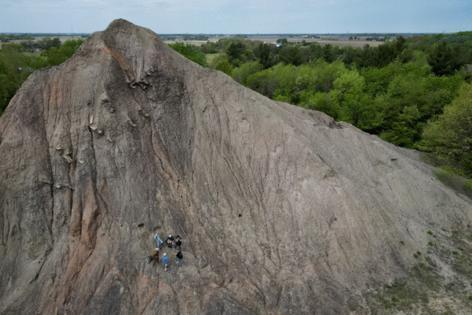The world's best-preserved fossils are right outside Chicago. But there are no dinosaur bones at Mazon Creek
Published in News & Features
CHICAGO — Sixty-five miles southwest of Chicago, a small hill that looks like a prop from an Indiana Jones movie breaks up the flat, monotone landscape. Consisting of shale, sandstone and rocks from an old coal mine, the waste pile — located on a massive river delta from another era — is an unremarkable remnant from the region’s once-thriving coal industry.
Except it contains many of the world’s best-preserved, most diverse fossils.
The defunct mine’s location in Grundy County is one of several sites spanning six counties that belong to the Mazon Creek fossil beds, a time capsule dating back some 309 million years — way before the age of dinosaurs — to the Carboniferous period, when large coal deposits formed around the world and terrestrial ecosystems developed. At the time, this area was swampy and tropical, and home to various organisms like the Illinois state fossil, the peculiar Tully monster, which has been found only here — a cigar-shaped vertebrate creature up to a foot long with eyes that protruded sideways, a long snout and a toothy mouth.
“You get everything from insects, millipedes, plants, jellyfish, all the way to early tetrapods, big animals like embolomeri, as well as larval forms,” said Arjan Mann, who recently joined the museum as an assistant curator of fossil fishes and early tetrapods, or four-limbed animals, such as the crocodile-like and predatory embolomeri. “This makes Mazon Creek the most complete record of a Paleozoic ecosystem” — an era that contained six periods and spanned from 541 million to 252 million years ago.
Despite their uniqueness, these sites remain relatively unknown to many outside paleontology circles. Maybe because no dinosaur bones have ever been found in this area or the rest of Illinois, and those tend to draw the most attention.
Even as the Field Museum celebrates on Friday 25 years since the arrival of famed Sue the T. rex to its halls after the bones were discovered in South Dakota, some scientists are shining a light on other creatures and plants that once roamed and grew in Illinois.
Mann’s role as a paleontologist, specifically at the Field Museum, was recently ranked the second-coolest job in the country on a career.io survey. And he wants to make the science more accessible, regardless of age or expertise, by collaborating with amateur fossil collectors from the Earth Science Club of Northern Illinois to find new specimens.
The club and museum take amateur fossil hunters to Mazon Creek sites on public land like state parks, where permits are required, as well as on private property like the Grundy County site they recently visited where they have an established relationship with the landowners.
In 1946, the museum hired Eugene Richardson as curator of fossil invertebrates, and he became a strong advocate for collaborating with amateur fossil collectors in Mazon Creek localities. Since Richardson’s death in 1983, paleontological research at the institution has skewed toward dinosaurs, Mann said. Now, he wants to renew the museum’s focus on Mazon Creek.
“I did my dissertation entirely on this site, even though I’m from Canada,” Mann said. “So my love for this site and my knowledge of what it was in the past, gives me a drive to want to revitalize both the scientific research to show how important the locality is, (and) how important it is as a social experiment — and how we can involve people at all levels.”
Treasure hunting
Rich Holm, a software engineer, joined the club about 20 years ago with his daughter, Anna. While picking through the pea gravel in their Naperville backyard, she’d found tiny fossils of a now-extinct, horn-shaped coral and a brachiopod — a marine animal that resembles a clam. A visit to a gift shop that sold stones and crystals solidified Anna’s interest and she told Holm she wanted to collect rocks.
“I said, ‘Sure, that’s fine,'” he recalled. Which is how he ended up on the club’s website and began taking her to junior group outings. “Now I’m on the board of directors.”
Holm said the paleontology experiences fostered a love for science in Anna, who went on to study microbiology in college. Sometimes she’ll join him on one of his 20 to 40 yearly collecting field trips. On one trip, he found a fossilized Paleocampa anthrax , a rare, extinct worm with bristles that make it look like a caterpillar and is related to modern-day fireworms. He has also found a fossilized tailless whip scorpion, of the extinct species Graeophonus carbonatius; arachnids like this are rare and coveted among collectors.
But acquiring rare specimens requires patience and identifying a lot of concretions, or mineral masses that sometimes contain fossils. The shape of a concretion generally offers a clue into what’s inside, so collectors want to bring back as many as possible to open, Holm said.
At the recent Mazon Creek dig, participants used pickaxes to sift through the waste pile, known as a spoil tip.
“Can I give you some of the stuff in my pocket?” Mann asked a colleague as he stood on top of the spoil tip. “It’s weighing me down.”
In a comical scene, he started pulling out rock after rock. “You just keep getting them,” Mann laughed.
“And it’s like a second collection experience when you open them,” he said. “These act as little time capsules that entomb animals within them.”
Holm has found so many fossils that he often gives them away to family, friends and even co-workers, who proudly display the gifts on their desks.
“You can get buried” in a collection, he joked. “So I give them away quite readily.”
While some prefer to crack the concretions with a hammer for faster results, this can damage the fossil inside. Experts suggest opening the Mazon Creek stones by alternately freezing and thawing them in water. As the liquid freezes and expands, it gently cracks the rocks open by putting pressure on their weakest points.
This method often requires that collectors’ families make room for the fossils at home.
“It’s a passion that just grows exponentially,” Holm said. “So, probably very soon after you start, you need a freezer of your own.”
For Father’s Day one year, Holm’s wife gave him one that he put in his basement. It is always stacked full of containers with concretions from different sites.
“It can sometimes take six months to a year for some to open,” Holm said. “I go down there almost every other day, and I’m constantly cycling the containers and checking. So that’s where the treasure hunt can continue all year round.”
Participants in the Grundy County fossil hunt are still in the freeze-thaw stage for the concretions they found that day.
Jeff Allen, another member of the club, uses half of the freezer in his basement to store his frozen fossils. “I have a very patient wife,” he chuckled.
“That’s the kind of enthusiasm that these collectors have,” Mann said. “As the Field Museum, we would never be able to do the kind of operation that we’re able to accomplish involving local collectors who are doing this work, and having good relationships with them.”
A snapshot in time
Mann and a colleague have set out to find the missing stage between the anatomies of primitive amphibians and modern ones, hoping the fossils in the 309 million-year-old Mazon Creek hold the answer.
Some modern amphibians have long had body characteristics that make them easily recognizable: frogs with powerful hind legs and salamanders with forelimbs and long tails. Less universally familiar but still peculiar is another kind of amphibian that’s still around today, the so-called caecilians, which have long, legless, snake-like bodies and spend most of their lives underground.
“But the thing is, if you go back into the fossil record, you basically see them maintaining the same body plan for about 250 million years. And before that, we have nothing,” said Cal So, a postdoctoral scientist at the museum who specializes in amphibians. “This time period essentially provides a really good place to look for what some of these early relatives of amphibians looked like. That’s one of the biggest mysteries in paleontology — evolutionary biology in general.”
The fossils in Mazon Creek offer a snapshot in time from hundreds of millions of years ago, when high oxygen levels, coal deposits and rapid burial caused many plants and animals, including soft tissues, to be well-preserved.
Mann looked toward the top of the waste pile. “When you go up, it’s like you’re going back in time,” he said. “When you see topology like this, rounded hills are probably spoil piles. And if you dig into these, there’s a good chance you’re going to find a concretion.”
The Mazon Creek fossil beds include a variety of sites, including local mine spoil piles, no-dig zones like the Mazonia-Braidwood State Fish and Wildlife Area, which requires a permit, and other localities that require sifting through rocks and silt on riverbeds and riverbanks, or bushwhacking through overgrown vegetation.
Fossils in the state are not just limited to this one area. Paleontologists also visit Danville and surrounding areas in east central Illinois, and the Little Egypt region around Cairo in far southern Illinois.
“This geologic history is really all over Illinois. And Mazon Creek could be a gateway into that for people,” Mann said. “That’s really what this locality is about. It’s about the intersection between private collectors, amateur paleontologists and professionals, and working together synergistically to unveil the natural history data here — and getting kids hooked on fossils when they’re young.”
____
©2025 Chicago Tribune. Visit at chicagotribune.com. Distributed by Tribune Content Agency, LLC.







Comments